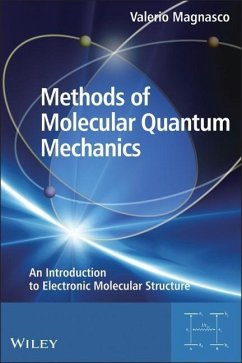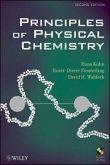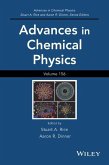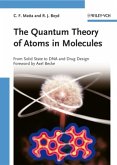Valerio Magnasco
Methods of Molecular Quantum Mechanics
An Introduction to Electronic Molecular Structure
Valerio Magnasco
Methods of Molecular Quantum Mechanics
An Introduction to Electronic Molecular Structure
- Broschiertes Buch
- Merkliste
- Auf die Merkliste
- Bewerten Bewerten
- Teilen
- Produkt teilen
- Produkterinnerung
- Produkterinnerung
This provides an advanced text introducing graduate students to the mathematical foundations of methods needed to do working applications in molecular quantum mechanics. It contains a consistent use of atomic units from the very beginning for simplifying mathematical formulae, and presents a unified presentation of basic elements of atomic and molecular interactions, with particular emphasis on practical use of second-order calculation techniques.
Andere Kunden interessierten sich auch für
![Atomic Charges, Bond Properties, and Molecular Energies Atomic Charges, Bond Properties, and Molecular Energies]() Sandor FliszarAtomic Charges, Bond Properties, and Molecular Energies156,99 €
Sandor FliszarAtomic Charges, Bond Properties, and Molecular Energies156,99 €![Molecular Interactions Molecular Interactions]() David MichaMolecular Interactions190,99 €
David MichaMolecular Interactions190,99 €![Principles of Physical Chemistry Principles of Physical Chemistry]() Hans KuhnPrinciples of Physical Chemistry143,99 €
Hans KuhnPrinciples of Physical Chemistry143,99 €![Quantum Electrodynamics Quantum Electrodynamics]() Akbar SalamQuantum Electrodynamics182,99 €
Akbar SalamQuantum Electrodynamics182,99 €![Advances in Chemical Physics, Volume 155 Advances in Chemical Physics, Volume 155]() Advances in Chemical Physics, Volume 155235,99 €
Advances in Chemical Physics, Volume 155235,99 €![Advances in Chemical Physics, Volume 156 Advances in Chemical Physics, Volume 156]() Stuart A. RiceAdvances in Chemical Physics, Volume 156234,99 €
Stuart A. RiceAdvances in Chemical Physics, Volume 156234,99 €![The Quantum Theory of Atoms in Molecules The Quantum Theory of Atoms in Molecules]() Chérif F. Matta / Russell J. Boyd (eds.)The Quantum Theory of Atoms in Molecules246,99 €
Chérif F. Matta / Russell J. Boyd (eds.)The Quantum Theory of Atoms in Molecules246,99 €-
-
-
This provides an advanced text introducing graduate students to the mathematical foundations of methods needed to do working applications in molecular quantum mechanics. It contains a consistent use of atomic units from the very beginning for simplifying mathematical formulae, and presents a unified presentation of basic elements of atomic and molecular interactions, with particular emphasis on practical use of second-order calculation techniques.
Hinweis: Dieser Artikel kann nur an eine deutsche Lieferadresse ausgeliefert werden.
Hinweis: Dieser Artikel kann nur an eine deutsche Lieferadresse ausgeliefert werden.
Produktdetails
- Produktdetails
- Verlag: Wiley & Sons
- 1. Auflage
- Seitenzahl: 304
- Erscheinungstermin: 1. Januar 2010
- Englisch
- Abmessung: 228mm x 151mm x 22mm
- Gewicht: 504g
- ISBN-13: 9780470684412
- ISBN-10: 0470684410
- Artikelnr.: 28163372
- Herstellerkennzeichnung
- Libri GmbH
- Europaallee 1
- 36244 Bad Hersfeld
- gpsr@libri.de
- Verlag: Wiley & Sons
- 1. Auflage
- Seitenzahl: 304
- Erscheinungstermin: 1. Januar 2010
- Englisch
- Abmessung: 228mm x 151mm x 22mm
- Gewicht: 504g
- ISBN-13: 9780470684412
- ISBN-10: 0470684410
- Artikelnr.: 28163372
- Herstellerkennzeichnung
- Libri GmbH
- Europaallee 1
- 36244 Bad Hersfeld
- gpsr@libri.de
Dr Valerio Magnasco, MRSC, is full Professor of Theoretical Chemistry at the University of Genoa, Italy, presently at the Department of Chemistry and Industrial Chemistry (DCCI) of the Faculty of Mathematical, Physical and Natural Sciences of the University. He is Member of the Royal Society of Chemistry (UK, RSC), the American Institute of Physics (US, AIP), the Physical Chemistry Division of the Italian Chemical Society (Italy, SCI), the Class of Sciences of Accademia Ligure di Scienze e Lettere (Italy, Genova). He is supervising a research group working on the theoretical study of atomic and molecular interactions, and is author or co-author of over 170 scientific papers mostly published on international journals, and of one book on Molecular Quantum Mechanics.
Preface.
1. Principles.
1.1 The Orbital Model.
1.2 Mathematical Methods.
1.3 Basic Postulates.
1.4 Physical Interpretation of the Basic Principles.
2. Matrices.
2.1 Definitions and Elementary Properties.
2.2 Properties of Determinants.
2.3 Special Matrices.
2.4 The Matrix Eigenvalue Problem.
3. Atomic Orbitals.
3.1 Atomic Orbitals as a Basis for Molecular Calculations.
3.2 Hydrogen-like Atomic Orbitals.
3.3 Slater-type Orbitals.
3.4 Gaussian-type Orbitals.
4. The Variation Method.
4.1 Variation Principles.
4.2 Nonlinear Parameters.
4.3 Linear Parameters and the Ritz Method.
4.4 Applications of the Ritz Method.
5. Spin.
5.1 The Zeeman Effect.
5.2 The Pauli Equations for One-electron Spin.
5.3 The Dirac Formula for N-electron Spin.
6. Antisymmetry of Many-electron Wavefunctions.
6.1 Antisymmetry Requirement and the Pauli Principle.
6.2 Slater Determinants.
6.3 Distributions Functions.
6.4 Average Values of Operators.
7. Self-consistent-field Calculations and Model Hamiltonians.
7.1 Elements of Hartree-Fock Theory for Closed Shells.
7.2 Roothaan Formulation of the LCAO-MO-SCF Equations.
7.3 Molecular Self-consistent-field Calculations.
7.4 Hückel Theory.
7.5 A Model for the One-dimensional Crystal.
8. Post-Hartree-Fock Methods.
8.1 Configuration Interaction.
8.2 Multiconfiguration Self-consistent-field.
8.3 Møller-Plesset Theory.
8.4 The MP2-R12 Method.
8.5 The CC-R12 Method.
8.6 Density Functional Theory.
9. Valence Bond Theory and the Chemical Bond.
9.1 The Born-Oppenheimer Approximation.
9.2 The Hydrogen Molecule H2.
9.3 The Origin of the Chemical Bond.
9.4 Valence Bond Theory and the Chemical Bond.
9.5 Hybridization and Molecular Structure.
9.6 Pauling's Formula for Conjugated and Aromatic Hydrocarbons.
10. Elements of Rayleigh-Schroedinger Perturbation Theory.
10.1 Rayleigh-Schroedinger Perturbation Equations.
10.2 First-order Theory.
10.3 Second-order Theory.
10.4 Approximate E2 Calculations: The Hylleraas Functional.
10.5 Linear Pseudostates and Molecular Properties.
10.6 Quantum Theory of Magnetic Susceptibilities.
11. Atomic and Molecular Interactions.
11.1 The H-H Nonexpanded Interactions up to Second Order.
11.2 The H-H Expanded Interactions up to Second Order.
11.3 Molecular Interactions.
11.4 Van der Waals and Hydrogen Bonds.
11.5 The Keesom Interaction.
12. Symmetry.
12.1 Molecular Symmetry.
12.2 Group Theoretical Methods.
12.3 Illustrative Examples.
References.
Author Index.
Subject Index.
1. Principles.
1.1 The Orbital Model.
1.2 Mathematical Methods.
1.3 Basic Postulates.
1.4 Physical Interpretation of the Basic Principles.
2. Matrices.
2.1 Definitions and Elementary Properties.
2.2 Properties of Determinants.
2.3 Special Matrices.
2.4 The Matrix Eigenvalue Problem.
3. Atomic Orbitals.
3.1 Atomic Orbitals as a Basis for Molecular Calculations.
3.2 Hydrogen-like Atomic Orbitals.
3.3 Slater-type Orbitals.
3.4 Gaussian-type Orbitals.
4. The Variation Method.
4.1 Variation Principles.
4.2 Nonlinear Parameters.
4.3 Linear Parameters and the Ritz Method.
4.4 Applications of the Ritz Method.
5. Spin.
5.1 The Zeeman Effect.
5.2 The Pauli Equations for One-electron Spin.
5.3 The Dirac Formula for N-electron Spin.
6. Antisymmetry of Many-electron Wavefunctions.
6.1 Antisymmetry Requirement and the Pauli Principle.
6.2 Slater Determinants.
6.3 Distributions Functions.
6.4 Average Values of Operators.
7. Self-consistent-field Calculations and Model Hamiltonians.
7.1 Elements of Hartree-Fock Theory for Closed Shells.
7.2 Roothaan Formulation of the LCAO-MO-SCF Equations.
7.3 Molecular Self-consistent-field Calculations.
7.4 Hückel Theory.
7.5 A Model for the One-dimensional Crystal.
8. Post-Hartree-Fock Methods.
8.1 Configuration Interaction.
8.2 Multiconfiguration Self-consistent-field.
8.3 Møller-Plesset Theory.
8.4 The MP2-R12 Method.
8.5 The CC-R12 Method.
8.6 Density Functional Theory.
9. Valence Bond Theory and the Chemical Bond.
9.1 The Born-Oppenheimer Approximation.
9.2 The Hydrogen Molecule H2.
9.3 The Origin of the Chemical Bond.
9.4 Valence Bond Theory and the Chemical Bond.
9.5 Hybridization and Molecular Structure.
9.6 Pauling's Formula for Conjugated and Aromatic Hydrocarbons.
10. Elements of Rayleigh-Schroedinger Perturbation Theory.
10.1 Rayleigh-Schroedinger Perturbation Equations.
10.2 First-order Theory.
10.3 Second-order Theory.
10.4 Approximate E2 Calculations: The Hylleraas Functional.
10.5 Linear Pseudostates and Molecular Properties.
10.6 Quantum Theory of Magnetic Susceptibilities.
11. Atomic and Molecular Interactions.
11.1 The H-H Nonexpanded Interactions up to Second Order.
11.2 The H-H Expanded Interactions up to Second Order.
11.3 Molecular Interactions.
11.4 Van der Waals and Hydrogen Bonds.
11.5 The Keesom Interaction.
12. Symmetry.
12.1 Molecular Symmetry.
12.2 Group Theoretical Methods.
12.3 Illustrative Examples.
References.
Author Index.
Subject Index.
Preface.
1. Principles.
1.1 The Orbital Model.
1.2 Mathematical Methods.
1.3 Basic Postulates.
1.4 Physical Interpretation of the Basic Principles.
2. Matrices.
2.1 Definitions and Elementary Properties.
2.2 Properties of Determinants.
2.3 Special Matrices.
2.4 The Matrix Eigenvalue Problem.
3. Atomic Orbitals.
3.1 Atomic Orbitals as a Basis for Molecular Calculations.
3.2 Hydrogen-like Atomic Orbitals.
3.3 Slater-type Orbitals.
3.4 Gaussian-type Orbitals.
4. The Variation Method.
4.1 Variation Principles.
4.2 Nonlinear Parameters.
4.3 Linear Parameters and the Ritz Method.
4.4 Applications of the Ritz Method.
5. Spin.
5.1 The Zeeman Effect.
5.2 The Pauli Equations for One-electron Spin.
5.3 The Dirac Formula for N-electron Spin.
6. Antisymmetry of Many-electron Wavefunctions.
6.1 Antisymmetry Requirement and the Pauli Principle.
6.2 Slater Determinants.
6.3 Distributions Functions.
6.4 Average Values of Operators.
7. Self-consistent-field Calculations and Model Hamiltonians.
7.1 Elements of Hartree-Fock Theory for Closed Shells.
7.2 Roothaan Formulation of the LCAO-MO-SCF Equations.
7.3 Molecular Self-consistent-field Calculations.
7.4 Hückel Theory.
7.5 A Model for the One-dimensional Crystal.
8. Post-Hartree-Fock Methods.
8.1 Configuration Interaction.
8.2 Multiconfiguration Self-consistent-field.
8.3 Møller-Plesset Theory.
8.4 The MP2-R12 Method.
8.5 The CC-R12 Method.
8.6 Density Functional Theory.
9. Valence Bond Theory and the Chemical Bond.
9.1 The Born-Oppenheimer Approximation.
9.2 The Hydrogen Molecule H2.
9.3 The Origin of the Chemical Bond.
9.4 Valence Bond Theory and the Chemical Bond.
9.5 Hybridization and Molecular Structure.
9.6 Pauling's Formula for Conjugated and Aromatic Hydrocarbons.
10. Elements of Rayleigh-Schroedinger Perturbation Theory.
10.1 Rayleigh-Schroedinger Perturbation Equations.
10.2 First-order Theory.
10.3 Second-order Theory.
10.4 Approximate E2 Calculations: The Hylleraas Functional.
10.5 Linear Pseudostates and Molecular Properties.
10.6 Quantum Theory of Magnetic Susceptibilities.
11. Atomic and Molecular Interactions.
11.1 The H-H Nonexpanded Interactions up to Second Order.
11.2 The H-H Expanded Interactions up to Second Order.
11.3 Molecular Interactions.
11.4 Van der Waals and Hydrogen Bonds.
11.5 The Keesom Interaction.
12. Symmetry.
12.1 Molecular Symmetry.
12.2 Group Theoretical Methods.
12.3 Illustrative Examples.
References.
Author Index.
Subject Index.
1. Principles.
1.1 The Orbital Model.
1.2 Mathematical Methods.
1.3 Basic Postulates.
1.4 Physical Interpretation of the Basic Principles.
2. Matrices.
2.1 Definitions and Elementary Properties.
2.2 Properties of Determinants.
2.3 Special Matrices.
2.4 The Matrix Eigenvalue Problem.
3. Atomic Orbitals.
3.1 Atomic Orbitals as a Basis for Molecular Calculations.
3.2 Hydrogen-like Atomic Orbitals.
3.3 Slater-type Orbitals.
3.4 Gaussian-type Orbitals.
4. The Variation Method.
4.1 Variation Principles.
4.2 Nonlinear Parameters.
4.3 Linear Parameters and the Ritz Method.
4.4 Applications of the Ritz Method.
5. Spin.
5.1 The Zeeman Effect.
5.2 The Pauli Equations for One-electron Spin.
5.3 The Dirac Formula for N-electron Spin.
6. Antisymmetry of Many-electron Wavefunctions.
6.1 Antisymmetry Requirement and the Pauli Principle.
6.2 Slater Determinants.
6.3 Distributions Functions.
6.4 Average Values of Operators.
7. Self-consistent-field Calculations and Model Hamiltonians.
7.1 Elements of Hartree-Fock Theory for Closed Shells.
7.2 Roothaan Formulation of the LCAO-MO-SCF Equations.
7.3 Molecular Self-consistent-field Calculations.
7.4 Hückel Theory.
7.5 A Model for the One-dimensional Crystal.
8. Post-Hartree-Fock Methods.
8.1 Configuration Interaction.
8.2 Multiconfiguration Self-consistent-field.
8.3 Møller-Plesset Theory.
8.4 The MP2-R12 Method.
8.5 The CC-R12 Method.
8.6 Density Functional Theory.
9. Valence Bond Theory and the Chemical Bond.
9.1 The Born-Oppenheimer Approximation.
9.2 The Hydrogen Molecule H2.
9.3 The Origin of the Chemical Bond.
9.4 Valence Bond Theory and the Chemical Bond.
9.5 Hybridization and Molecular Structure.
9.6 Pauling's Formula for Conjugated and Aromatic Hydrocarbons.
10. Elements of Rayleigh-Schroedinger Perturbation Theory.
10.1 Rayleigh-Schroedinger Perturbation Equations.
10.2 First-order Theory.
10.3 Second-order Theory.
10.4 Approximate E2 Calculations: The Hylleraas Functional.
10.5 Linear Pseudostates and Molecular Properties.
10.6 Quantum Theory of Magnetic Susceptibilities.
11. Atomic and Molecular Interactions.
11.1 The H-H Nonexpanded Interactions up to Second Order.
11.2 The H-H Expanded Interactions up to Second Order.
11.3 Molecular Interactions.
11.4 Van der Waals and Hydrogen Bonds.
11.5 The Keesom Interaction.
12. Symmetry.
12.1 Molecular Symmetry.
12.2 Group Theoretical Methods.
12.3 Illustrative Examples.
References.
Author Index.
Subject Index.








